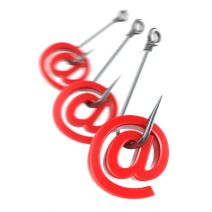Directive Blogs
Don’t Be Duped By a Phishing Attack: 4 Signs to Look Out For
 Your business is literally assaulted by thousands of threats a day, and they could ruin your organization's goals in an instant if not for your defenses. With such powerful security measures at your disposal, we don’t blame you for lowering your defenses; however, it should be mentioned that your network security doesn’t protect you from all manners of threats. Attacks like phishing scams have a tendency to bypass your security measures, which makes them dangerous.
Your business is literally assaulted by thousands of threats a day, and they could ruin your organization's goals in an instant if not for your defenses. With such powerful security measures at your disposal, we don’t blame you for lowering your defenses; however, it should be mentioned that your network security doesn’t protect you from all manners of threats. Attacks like phishing scams have a tendency to bypass your security measures, which makes them dangerous.
Hackers utilizing phishing attacks are attempting to trick your employees into handing over sensitive information through personalized attacks. These attempts usually involve the victims clicking on links which lead to websites or email attachments which are infected with malware. Hackers disguise their identities as those of legitimate organizations, then perform targeted spear phishing attacks using social engineering tactics. This means it’s more important than ever before to ensure that your team knows how to deal with these attacks, instead of giving in to them. Here are four ways you can identify common phishing attempts.
- Who’s sending the message? You should never trust an email from someone you don’t recognize, especially if they’re requesting sensitive information like your Social Security number or credit card number. If you’re unsure about the identity of the sender, hover over their name to see if the domain matches their identity. If all else fails, you can verify the contact information of the organization the sender is claiming to be from by checking official company documentation.
- Does the email demand immediate action? Hackers don’t have the patience to wait for you to identify them as phonies, so they’ll often rush you into giving up your information before you can even question them. Attackers will try to convince users that their response is of the utmost importance, and some will even offer incentives if you “claim your prize NOW!” Many of these are obviously fake, but for the more gullible people out there, they might seem perfectly normal. If something is truly an urgent matter, a phone call will probably be the option of choice for a professional contact; not an email.
- Are the URLs in the email legitimate? Hackers will often use fake URLs to lure users to phony websites, which may have forms designed to steal your information. Instead of falling into these traps, hover over URLs to ensure they are legitimate. If the site they’re posing as is one which normally has site encryption, look for [https://] in the link. If it doesn’t, try navigating to the official site in a separate browser window to ensure it is legitimate.
- Is the message just plain text? Most organizations use a combination of images and HTML in their email messages. If a message you receive consists only of text and hyperlinks, you’ll know that something is wrong. In some cases, hackers will simply make the message a whole clickable image, so be sure to take precautions when viewing questionable emails.
Of course, the best way to keep phishing attacks at bay is by eliminating them before they even reach your inbox. With Directive’s comprehensive spam blocking solution, you’ll have little fear of encountering phishing attacks. Still, it’s always best to approach any suspicious messages with skepticism. Give us a call at 607.433.2200 to find out how you can best protect your business from phishing attacks.

